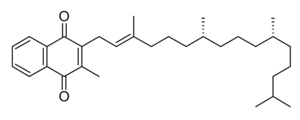Vitamin K
Vitamin K is group of compounds derivated from 2-methyl-1,4-naftochinon (IUPAC: 2-methylnaphthalene-1,4-dione).[1]
Role[edit | edit source]
It has an important role in normal blood clotting (factors II, VII, IX and X are vitamin K dependent, because it works as cofactor in carboxylation of glutamic acid to γ-carboxyglutamic acid which is essential for calcium binding on these factors), for synthesis of protein C and S and it is also needed to help build strong bones.
Role in coagulation therapy[edit | edit source]
The role of vitamin K is often exploited in anticoagulation treatments in patients with increased risk of thrombosis. These compounds used are referred to as vitamin K antagonists, many of these are coumarin based, the best know of which is warfarin. Coumarin based compounds function by preventing the conversion of the inactive epoxide form of vitamin K into its activated form by inhibiting the enzyme responsible for its reduction ( vitamin K epoxide reductase).
Alternative anticoagulation treatments include heparin (via the inactivation of thrombin) in vivo and EDTA, oxalate and citrate (which remove Ca2+) but can only be used in vitro due to the biological importance of Ca2+.
Source[edit | edit source]
It is found in green leafy vegetables, such as broccoli and spinach, pulses, vegetable oils, cereals, milk, milk products, meat, eggs and fruit. Bacteria in the intestines can also synthesis Vitamin K and contribute to the available pool.
- requirement: 1 µ/kg/day (except newborns)
Excess[edit | edit source]
This can cause the breakdown of red blood cells and also liver damage. Therefore if a person is taking blood-thinning agents, they may need to limit the amount of Vitamin K intake.
Note: Vitamin K is an antidote for warfarin.
Deficiency[edit | edit source]
It is very rare in adults, but can occur in individuals that cannot absorb it properly, due to lack of intestinal bacteria, as well as those being treated long term with antibiotics. It can cause excessive bleeding and increased tendency to bruise. It may also be the cause of haemorrhagic disease of newborn, because placental transfer of vitamin K is very low, its level in breast milk is low as well. (prevention: 1 mg of vit. K intramuscularly 2–6 hours after birth and then 1 mg of vit. K per os every week till age one month, and for exclusively breast feeded children till age 6 months[2]).
Links[edit | edit source]
Related articles[edit | edit source]
External links[edit | edit source]
References[edit | edit source]
- ↑ WIkiSkripta. Vitami K [online]. ©2011. The last revision 2011-11-29, [cit. 2012-01-26]. <http://www.wikiskripta.eu/index.php/Vitamin_K>.
- ↑ ZEMAN, Jiří. Od příznaků k diagnóze [lecture for subject Paediatrics, specialization General Medicine, 1st Faculty of Medicine Charles University in Prague]. Prague. 2011.
Bibliography[edit | edit source]
- BENCKO, Vladimir, et al. Hygiene and epidemiology : selected chapters. 2. edition. Prague. 2008. ISBN 80-246-0793-X.



